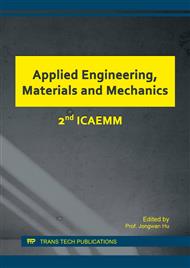[1]
J. E. Mark, B. Erman, C. M. Roland, The Science and Technology of Rubber, third ed., Academic Press, Boston, (2013).
Google Scholar
[2]
J. S. Dick, Rubber Technology: Compounding and Testing for Performance, second ed., Hanser Publishers, Munich, (2009).
Google Scholar
[3]
R. Fernandez Martinez, M. Iturrondobeitia, J. Ibarretxe, T. Guraya, Methodology to classify the shape of reinforcement fillers: optimization, evaluation, comparison, and selection of models, J. Mater. Sci. 52(1) (2017) 569-580.
DOI: 10.1007/s10853-016-0354-1
Google Scholar
[4]
R. Lostado, R. Escribano Garcia, R. Fernandez Martinez, Optimization of operating conditions for a double-row tapered roller bearing, Int. J. Mech. Mater. Des. 12(3) (2016) 353-373.
DOI: 10.1007/s10999-015-9311-4
Google Scholar
[5]
M. Illera, R. Lostado, R. Fernandez Martinez, B. J. Mac Donald, Characterization of electrolytic tinplate materials via combined finite element and regression models, J. Str. Anal. Eng. Des. 49(6) (2014) 467-480.
DOI: 10.1177/0309324714524398
Google Scholar
[6]
ASTM D2240-05, Standard Test Method for Rubber Property-Durometer Hardness, ASTM International, West Conshohocken, PA, www. astm. org, (2005).
Google Scholar
[7]
G. Taguchi, Y. Wu, Introduction to off-line quality control, Central Japan Quality Control As-sociation, Nagoya, Japan, (1980).
Google Scholar
[8]
G. Taguchi, System of experimental design: engineering methods to optimize quality and minimize cost, UNIPUB, White Plains, New York, (1987).
Google Scholar
[9]
G. Taguchi, Introduction to quality engineering, Asian Productivity Organization, UNIPUB, White Plains, New York, (1991).
Google Scholar
[10]
P. Rousseeuw, A. Leroy, Robust Regression and Outlier Detection, Wiley, (2003).
Google Scholar
[11]
J. F. Hair, W. C. Black, B. J. Babin, R. E. Anderson, Multivariate Data Analysis, 7th Edition, Pearson, (2010).
Google Scholar
[12]
R. Fernandez Martinez, F. J. Martinez-de-Pison Ascacibar, A. V. Pernia Espinoza, R. Lostado Lorza, Predictive modeling in grape berry weight during maturation process: Comparison of data mining, statistical and artificial intelligence techniques, Spn. J. Agric. Res. 9(4) (2011).
DOI: 10.5424/sjar/20110904-531-10
Google Scholar
[13]
R. Fernandez Martinez, A. Okariz, J. Ibarretxe, M. Iturrondobeitia, T. Guraya, Use of decision tree models based on evolutionary algorithms for the morphological classification of reinforcing nano-particle aggregates, Comput. Mater. Sci. 92 (2014).
DOI: 10.1016/j.commatsci.2014.05.038
Google Scholar
[14]
K. Pearson, On Lines and Planes of Closest Fit to Systems of Points in Space, Philosophical Mag. 2(11) (1901) 559-572.
DOI: 10.1080/14786440109462720
Google Scholar
[15]
I. T. Jolliffe, Chapter 6: Choosing a Subset of Principal Components or Variables, in: Principal Component Analysis, 2nd edition, Springer, New York, (2002).
DOI: 10.1007/978-1-4757-1904-8_6
Google Scholar
[16]
H. Abdi, L. J. Williams, Principal component analysis, Wiley Interdisciplinary Reviews: Comput. Stat. 2(4) (2010) 433-459.
DOI: 10.1002/wics.101
Google Scholar
[17]
G. N. Wilkinson, C. E. Rogers, Symbolic descriptions of factorial models for analysis of variance, Appl. Stat. 22 (1973) 392-399.
Google Scholar
[18]
J. M. Chambers, Chapter 4: Linear models, in: Statistical Models in S, Eds J. M. Chambers and T. J. Hastie, Wadsworth & Brooks/Cole, (1992).
Google Scholar
[19]
R Core Team, R: A language and environment for statistical computing. R Foundation for Statistical Computing, Vienna, Austria. URL https: /www. R-project. org/, (2016).
Google Scholar


